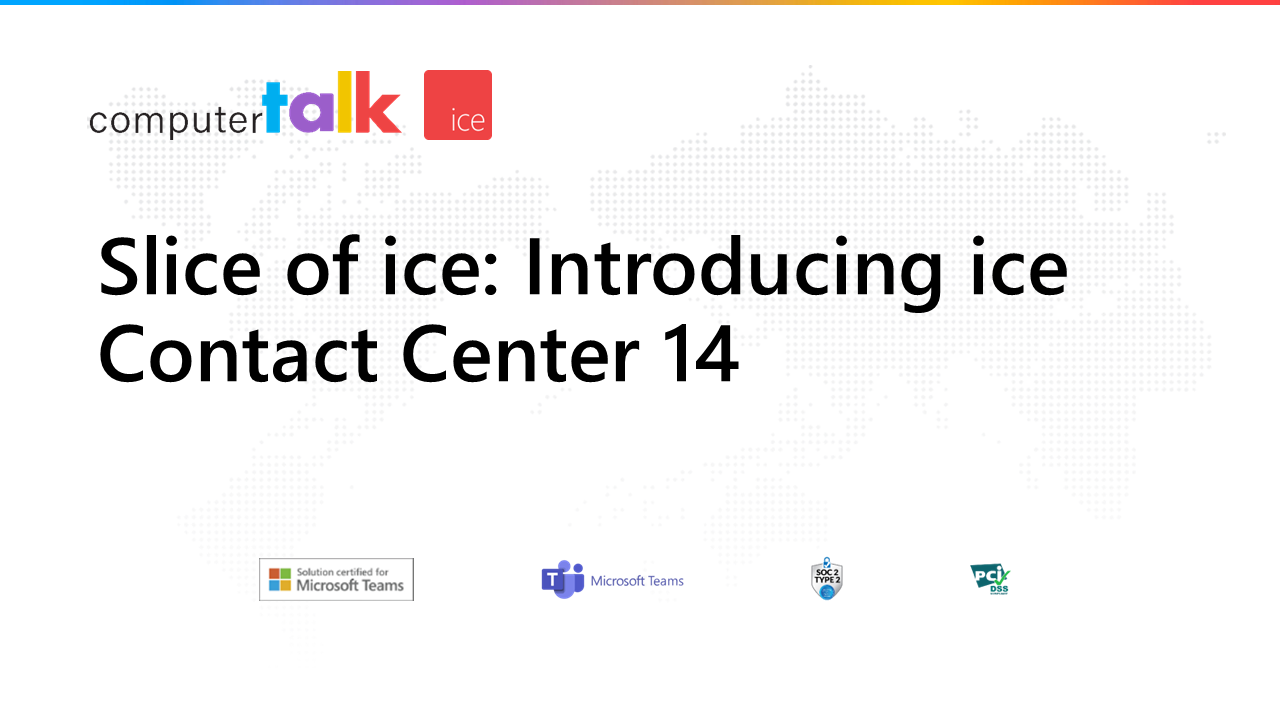Slice of ice Recap – Introducing ice Contact Center 14
by Shaundalee Carvalho | Published On September 20, 2024

On Wednesday, September 11th, ComputerTalk hosted our latest Slice of ice webinar. In this webinar, our Training and Documentation Specialist, Christina Liu, covered the benefits and features in our latest release, ice 14.
Click here to watch the full recording or read on for a summary.
ice 14 offers a number of new features and enhancements, including:
- LOB Tagging
- Post Call Transcription
- Contact Summarization
- Contact Metadata
- Monitor Alerts Based on State Time
- Audio Message Management
- Audit Trails
- Chat Enhancements
- AI in Workflow
iceJournal Enhancements
iceJournal enhancements in ice 14 include LOB tagging, post-call transcription, contact summarization, and contact metadata.
- LOB Tagging – In ice 14, users are able to tag calls with LOB codes in iceJournal after the call. To do this, select the call in iceJournal, click on the + next to LOBs Assigned, select the desired LOBs, and then click Submit.
- Post-call Transcription – This is available for users who have call recording enabled. After a call, ice will send the recording to a transcription provider. Once complete, users can view the transcript in iceJournal. To access it, select the call in iceJournal and scroll to the Transcript section near the bottom of the detailed view and expand the section. You can also download the transcript or open it in a new window. In a new window, you can listen to the recording and see the transcript text being highlighted to indicate your place in the recording.
- Contact Summarization – In ice 14, short, AI-generated summaries of calls are available out-of-the-box for users with call recording and transcription enabled. You can find a call summary in the contact details for the call in iceJournal.
- Contact Metadata - In addition to summaries, ice 14 allows the creation of new contact metadata fields and metadata jobs that run to generate additional information for the contact. For example, we could extract the customer’s reason for calling or generate next steps, all based on the transcript. These additional fields can be found under Contact Metadata in the contact details. Users can also filter by these fields when searching in iceJournal.
iceMonitor Enhancements
In ice 14, under the alerts builder in iceMonitor, there are a few new parameters, including State Time, Not Ready Reason, and Total Time and Count values for each Not Ready reason you have configured. You can make use of these by, for example, setting an alert to notify you when an agent has been on a lunch break for longer than an hour. In ice 14, you can also now select a color for your alert notifications.
Audio Message Management
Audio Message Management is a tool that allows administrators, supervisors, and team leads to manage their audio files in iceManager. This tool can be found in iceManager settings. It allows you to add an audio file by recording a message directly in your browser, using text-to-speech, or uploading a file. You can also search through audio messages using the Filter Text field.
Audit Trails
In ice 14, audit trails are available to let administrators view details of changes that have been made in the system, along with who made the changes and when they were made. A number of search filters allow the administrator to search for specific changes by users, date, and more. Additionally, administrators can see who accessed information such as call recordings, transcripts, evaluations, and call details.
Chat Enhancements
In ice 14, you can now embed iceChat directly into your website. There are also a number of settings that can be configured, such as message time and date format, minimum and maximum width of message bubbles, amount of space between messages, and border bubble radius and border thickness.
AI in Workflow
There are a number of AI functions available with the built-in Azure Toolkit that comes with ice 12 and later. For example, workflows can play a prompt using Azure Text-To-Speech, record an audio message, and invoke Azure Speech service to transcribe speech to text.
The Azure Toolkit in ice 13 and 14 has additional functionality. For example, it has the ability to invoke Azure OpenAI Service to start and continue a conversation with the bot, and to start and continue a conversation against an ice knowledge store database, which may contain text documents such as user manuals.
Reach Out to Learn More
If you’d like to learn more about ice 14 and how it can benefit your organization, reach out to your account owner or request a demo.
More from our blog
 As someone who has been going to in-person Microsoft conferences for 15 years, the last couple of years have been a real change in routine. There was always a regular cadence of two or three events a year, typically Build...
As someone who has been going to in-person Microsoft conferences for 15 years, the last couple of years have been a real change in routine. There was always a regular cadence of two or three events a year, typically Build...
 IVR (Interactive Voice Response) systems are becoming smarter and more intuitive all the time. They’re not just there to route a customer to the right agent anymore.
IVR (Interactive Voice Response) systems are becoming smarter and more intuitive all the time. They’re not just there to route a customer to the right agent anymore.
 ComputerTalk, a CCaaS provider located in Markham, Canada, is excited to announce the upcoming release of ice 13. Following the recent release of ice 12.1, version 13 provides more enhancements to the current features and tools. Continue reading to discover...
ComputerTalk, a CCaaS provider located in Markham, Canada, is excited to announce the upcoming release of ice 13. Following the recent release of ice 12.1, version 13 provides more enhancements to the current features and tools. Continue reading to discover...

